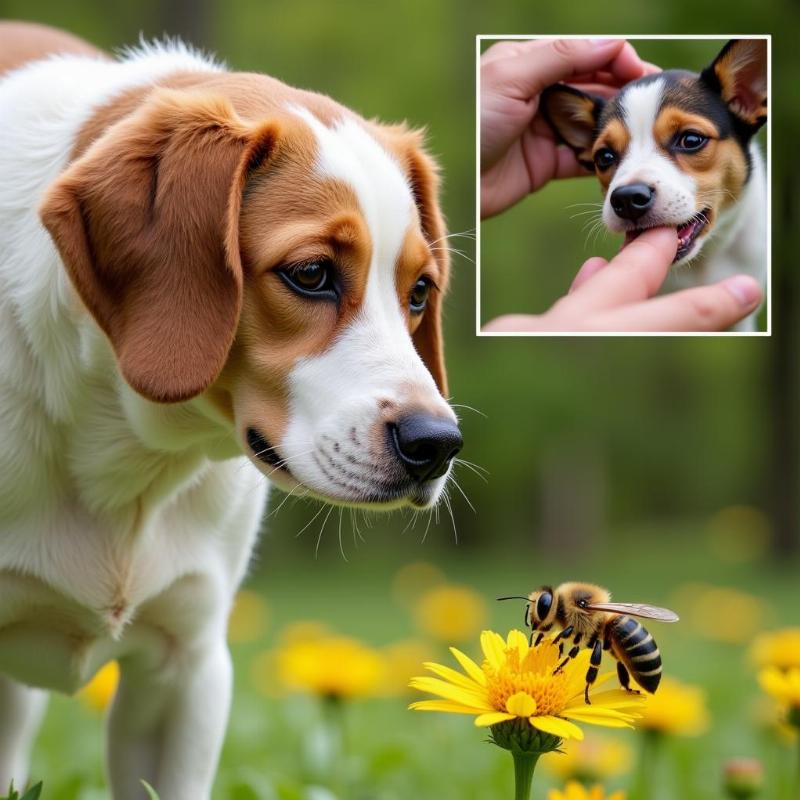If your furry friend just gobbled down a carpenter bee, you’re likely feeling a mix of panic and uncertainty. My dog ate a carpenter bee – it’s a surprisingly common search query, and understandably so. These large, buzzing insects can be tempting for curious canines, but their sting can pose a potential risk. This article will guide you through what to expect, what to watch for, and when to seek veterinary care if your dog ate a carpenter bee.
Understanding the Risks of Carpenter Bees
Carpenter bees, while crucial pollinators, pack a painful sting. Unlike honeybees, they can sting multiple times. While one sting might not be a major issue for most dogs, multiple stings, an allergic reaction, or a sting inside the mouth or throat can be serious. My dog ate a carpenter bee – this seemingly simple act can have varied consequences depending on the location of the sting and your dog’s individual sensitivity.
 Dog Eating a Carpenter Bee
Dog Eating a Carpenter Bee
Signs and Symptoms to Watch For
If your dog ate a carpenter bee, monitor them closely for any adverse reactions. Common symptoms include:
- Swelling: Look for swelling at the sting site, which could be on the face, in the mouth, or even down the throat. Swelling in the throat is particularly dangerous as it can obstruct the airway.
- Pain: Your dog may whine, paw at their face, or show other signs of discomfort.
- Redness and Itching: The sting site may appear red and irritated.
- Vomiting or Diarrhea: These can be signs of a more severe reaction.
- Difficulty Breathing: This is a medical emergency and requires immediate veterinary attention.
- Hives or Facial Swelling: These indicate an allergic reaction and require prompt veterinary care.
What to Do if Your Dog Eats a Carpenter Bee
First, try to remain calm. Panic can be contagious to your dog. If the sting is visible and accessible, you can try to remove the stinger if present (carpenter bees don’t usually leave their stinger behind, unlike honeybees). Applying a cold compress to the area can help reduce swelling and pain.
“If the sting is inside the mouth or throat, swelling can be a serious concern,” says Dr. Emily Carter, DVM, a veterinary specialist in allergy and immunology at the Animal Medical Center of New York. “It’s crucial to seek immediate veterinary attention in these cases.”
When to Seek Veterinary Care
While a single carpenter bee sting may not warrant a trip to the vet for most dogs, there are certain situations where immediate veterinary care is essential:
- Sting inside the mouth or throat: Swelling can obstruct the airway.
- Multiple stings: The cumulative effect of the venom can be dangerous.
- Signs of an allergic reaction: This includes hives, facial swelling, difficulty breathing, or collapse.
- Pre-existing health conditions: Dogs with compromised immune systems or other health problems may be more susceptible to severe reactions.
Preventing Future Encounters
While completely eliminating the risk of your dog encountering a carpenter bee is challenging, you can take steps to minimize the chances:
- Be mindful of carpenter bee activity: These bees are often found around wooden structures like decks, fences, and eaves.
- Keep your dog away from known nesting areas: Fill any holes or cracks in wood where carpenter bees might be nesting.
- Provide distractions: Keep your dog occupied with toys or activities while outdoors.
- Train your dog to “leave it”: This command can be invaluable in preventing your dog from investigating buzzing insects.
Conclusion
Discovering that your dog ate a carpenter bee can be alarming. By staying vigilant, knowing the signs of a reaction, and seeking veterinary care when necessary, you can help ensure your furry friend’s safety and well-being. Remember, swift action is key in managing potential complications.
FAQs
- Are carpenter bees aggressive? Carpenter bees are generally not aggressive unless they feel threatened or their nest is disturbed.
- Can a dog die from a bee sting? Yes, although rare, a severe allergic reaction to a bee sting can be fatal if not treated promptly.
- What will the vet do if my dog is stung? The vet may administer antihistamines, steroids, or other medications to manage the reaction. In severe cases, they may provide supportive care such as oxygen therapy.
- How can I tell if my dog is having an allergic reaction? Signs of an allergic reaction include hives, facial swelling, difficulty breathing, vomiting, and collapse.
- How long does the swelling from a bee sting last? Swelling typically subsides within a few days, but it can last longer in some cases.
- Can I give my dog Benadryl for a bee sting? While Benadryl can be helpful, it’s important to consult with your veterinarian before giving any medication to your dog.
- How can I prevent my dog from eating bees in the future? Train your dog to “leave it,” be mindful of bee activity, and keep your dog away from known nesting areas.
Beautdogs.us is your premier online resource for comprehensive dog care information, breed-specific guidance, and expert advice. Whether you’re a new dog owner or a seasoned pro, Beautdogs.us offers authoritative and engaging content to help you navigate every aspect of dog ownership. For personalized advice or inquiries, connect with us at [email protected] or call us at +1 501-555-7529. Visit Beautdogs.us today for all your dog care needs!